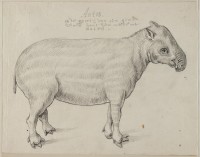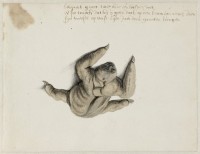 In 1636, Johan Maurits, Count of Nassau-Siegen, (if the name rings a bell it’s because his house in The Hague is now the magnificent Mauritshuis museum) was appointed the Dutch West India Company (DWIC) governor of what was then the Dutch colony of Brazil. His mission was to stabilized the new colony, wrested from Portugal after nine years of war, expand its territories and increase the number of sugar plantations putting money in the DWIC’s coffers. He landed in Recife in January of 1637 with a large retinue including scientists and artists to document the people, environments, plants and animals they came across.
In 1636, Johan Maurits, Count of Nassau-Siegen, (if the name rings a bell it’s because his house in The Hague is now the magnificent Mauritshuis museum) was appointed the Dutch West India Company (DWIC) governor of what was then the Dutch colony of Brazil. His mission was to stabilized the new colony, wrested from Portugal after nine years of war, expand its territories and increase the number of sugar plantations putting money in the DWIC’s coffers. He landed in Recife in January of 1637 with a large retinue including scientists and artists to document the people, environments, plants and animals they came across.
 One of those artists was Frans Post. Born in Haarlem in 1612, he was the son of a noted glass painter and brother of one of the premier architects of the age both of whom taught him to draw and paint when he was a youth. His brother helped him secure a post at court where he spotted by Maurits who invited him to join him in Brazil. Post traveled throughout Dutch Brazil until 1644, sketching and painting landscapes, flora and fauna. He was the first European artist (professional anyway) to paint New World landscapes.
One of those artists was Frans Post. Born in Haarlem in 1612, he was the son of a noted glass painter and brother of one of the premier architects of the age both of whom taught him to draw and paint when he was a youth. His brother helped him secure a post at court where he spotted by Maurits who invited him to join him in Brazil. Post traveled throughout Dutch Brazil until 1644, sketching and painting landscapes, flora and fauna. He was the first European artist (professional anyway) to paint New World landscapes.
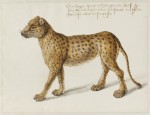 He only completed six paintings (later gifted by Maurits to Louis XIV of France) while still in Brazil, but he continued to paint Brazilian landscapes after his return to the Netherlands for another 25 years. They were very popular and sold briskly, eventually entering the collections of several museums. Art historians suspected that Post must have used studies done during his time in Brazil to create the paintings made in the Netherlands, but not a single sketch or drawing of Brazilian flora or fauna by Post was known to exist.
He only completed six paintings (later gifted by Maurits to Louis XIV of France) while still in Brazil, but he continued to paint Brazilian landscapes after his return to the Netherlands for another 25 years. They were very popular and sold briskly, eventually entering the collections of several museums. Art historians suspected that Post must have used studies done during his time in Brazil to create the paintings made in the Netherlands, but not a single sketch or drawing of Brazilian flora or fauna by Post was known to exist.
![Six-banded Armadillo [Yellow Armadillo], Frans Post (1612–1680), watercolor and gouache, with pen and gray ink, over graphite, c. 1638–44 translated inscription: TATVPEBA. A kind of armored pig. Good to eat, tastes like a chicken Noord-Hollands Archief, Haarlem .](http://www.thehistoryblog.com/wp-content/uploads/2016/09/Gordeldier-Frans-Post-ca.-1638-1644.-Noord-Hollands-Archief-Haarlem-150x115.jpg) That changed in 2010 when Alexander de Bruin, curator of the image collection of the Noord-Hollands Archief in Haarlem discovered 34 previously unknown drawings by Frans Post. He found them in a 17th century album of bird drawings by Pieter Holsteijn the Elder and the Younger that he was looking through for a digitization project. The album had been donated in 1888, but nobody noticed the pencil sketches and gouaches of capybaras, jaguars, tapirs, sloths, caymans and other South American animals until de Bruin.
That changed in 2010 when Alexander de Bruin, curator of the image collection of the Noord-Hollands Archief in Haarlem discovered 34 previously unknown drawings by Frans Post. He found them in a 17th century album of bird drawings by Pieter Holsteijn the Elder and the Younger that he was looking through for a digitization project. The album had been donated in 1888, but nobody noticed the pencil sketches and gouaches of capybaras, jaguars, tapirs, sloths, caymans and other South American animals until de Bruin.
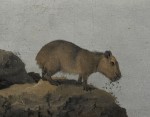 Because the discovery was unprecedented, experts from the Noord-Hollands Archief, the journal Master Drawings, and the Rijksmuseum put their heads together to confirm that the really were the long-suspected Frans Post Brazilian studies. They compared the subjects — individual animals captures in 24 watercolor and gouache drawings and 10 graphite ones — to animals in finished paintings and found that they were indeed studies used in
Because the discovery was unprecedented, experts from the Noord-Hollands Archief, the journal Master Drawings, and the Rijksmuseum put their heads together to confirm that the really were the long-suspected Frans Post Brazilian studies. They compared the subjects — individual animals captures in 24 watercolor and gouache drawings and 10 graphite ones — to animals in finished paintings and found that they were indeed studies used in 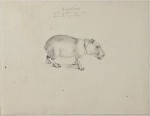
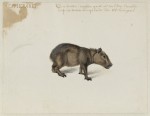 his landscapes. One of the paintings he did in Brazil, for example, now in the Louvre, prominently features a capybara who appears in both a graphite sketch and a gouache. The graphite sketches are captioned in Post’s own hand; the gouaches in an unknown 17th century hand which assures us that armadillo tastes like chicken.
his landscapes. One of the paintings he did in Brazil, for example, now in the Louvre, prominently features a capybara who appears in both a graphite sketch and a gouache. The graphite sketches are captioned in Post’s own hand; the gouaches in an unknown 17th century hand which assures us that armadillo tastes like chicken.
Alexander de Bruin on the find:
“These drawings with their inscriptions have a immediacy about them that makes you feel as if you were looking over Frans Post’s shoulder, as he recorded the fascinating fauna of the New World. The animal studies provide the missing link between Post’s seven-year Brazilian adventure and the paintings he produced on his return to Haarlem.”
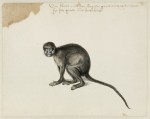 The drawings will go on display for the first time in the upcoming Rijksmuseum exhibition Frans Post. Animals in Brazil. Six of his paintings and all of the studies will be exhibited alongside taxidermied specimens from the Naturalis Biodiversity Center in Leiden of the animals Post drew. The exhibition opens October 7th and runs through January 8th, 2017.
The drawings will go on display for the first time in the upcoming Rijksmuseum exhibition Frans Post. Animals in Brazil. Six of his paintings and all of the studies will be exhibited alongside taxidermied specimens from the Naturalis Biodiversity Center in Leiden of the animals Post drew. The exhibition opens October 7th and runs through January 8th, 2017.
